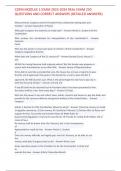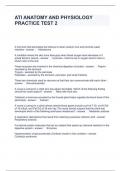CDFM MODULE 1 EXAM 2023-2024 REAL EXAM 250
QUESTIONS AND CORRECT ANSWERS (DETAILED ANSWERS)
What prevents Congress and the President from unilaterally making laws and
treaties? - Answer Separation of Power
What give Congress the authority to make laws? - Answer Article 1, Section 8 of the
Constitution
Who reviews the constitution for interpretation of the constitution? - Answer
Supreme
Court
Who has the power to raise taxes given in Article 1 of the Constitution? - Answer
Congress (Legislative Branch)
What does the Congress of the US consist of? - Answer Senate (6 yrs); House (2
yrs)
All bills for raising Revenue shall originate where? But the Senate may propose or
concur with Amendments as on other Bills. - Answer House of Representative
To be able to override a presidential veto, the House has to have a majority to pass
the bill; and if approved, then goes to the Senate for a vote to pass the bill. If
approved, the Bill becomes Law. What is the percentage the vote has to pass by in
both the House & Senate? - Answer 2/3 and 2/3
If any Bill shall not be returned by the President after it has been presented to him,
the Same shall be a law. How many days? - Answer 10 Days
Who has the power to lay and collect taxes, duties, imposts and Excises to pay the debts and
provide for the common defense and general welfare of the United States. - Answer
Congress
Article 1, Section 8 of the Constitution allows for what? - Answer 1) borrow money on credit
2) regulate commerce; 3) Coin money; 4) Constitute Tribunals; 5) Declare War; 6) Raise and
support Armies; 7) provide and maintain Navy; 8) Make Rules for
Government Regulation of land and naval forces; 9) Provide for calling forth Militia; 10) to
make all laws
No money shall be drawn from the Treasury, but in the Consequence
of
Appropriations made by law. - Answer Article 1, Section
9
Once the money officially and legally gets into the Treasury, to be able to use
the
money, what does Congress have to do? - Answer Write a Law
Gives executive power to the President to be the Commander in Chief and
to
execute the laws - Answer Article 2 Executive Branch
,CDFM MODULE 1 EXAM 2023-2024 REAL EXAM 250
QUESTIONS AND CORRECT ANSWERS (DETAILED ANSWERS)
The President has the power to nominate and with the advice and consent of the
Senate, shall appoint these officials. Name 2? - Answer Ambassadors & Supreme Court
Judges
How often does the President give to Congress the State of the Union (Jan/Feb) time
frame. - Answer Once year
Who and what branch is responsibly for faithfully executing the laws enacted by
Congress (Legislative Branch)? - Answer President (Executive Branch)
The Supreme Court does not deal in the matter of what? - Answer State Laws
A new Congress convenes for two years following the November general elections, it consists
of how many sessions, and each in what duration? - Answer 2 sessions; 1 year duration
This may originate either in the House of Representatives or in the Senate. There is
little practice difference between a bill and a " ", once agree, it goes to the President
for signature. - Answer Joint Resolution
Matters affecting the operation of the House & Senate and both chambers agree,
does not go to the President for signature. - Answer Concurrent Resolution
The House and Senate can each write an matter concerning the operation on its own.
Applies to the chamber that created it. Knows as the H.Res & S.Res - Answer Simple
Resolution
During the State of The Union, what message is the President giving? - Answer
State of Union, recommend measures necessary and expedient
Can an Executive Branch Department pass legislation with the approval of OMB and on
Behalf of the president, to a congressional committee or subcommittee - Answer Yes, but
must be approved by OMB
Who resolves differences between the HR and the Senate? - Answer Conference
Committee (Third Chamber)
What is usually the first step in the process for consideration by committee? - Answer
Public Hearing
When a Conference Committee is convened dealing with an amendment, what can
the conferees do and not do? - Answer Only deal with matters in disagreement;
cannot insert new matter or leave out matter agreed on
The final step after the Conference Committee Resolution after a measure has been
passed in identical form by both the House andSenate, it is considered to be what? -
Answer "Enrolled" (then sent to the president)
What was declared unconstitutional in 1998 with respect to Presidential Veto? -
Answer Line Item Veto
If the President Veto a Bill, it is returned to the house of original acting first. If the Bill
does not receive 2/3 vote, it is sustained and the bill fails to become law. If it receives
,CDFM MODULE 1 EXAM 2023-2024 REAL EXAM 250
QUESTIONS AND CORRECT ANSWERS (DETAILED ANSWERS)
the required 2/3 vote, an endorsement to the effect is made on the back of the bill
and it is then transmitted, with the accompany message, the to the second house for
its action. What has to happen for the Bill to become Law? - Answer The next house
has to pass it with a 2/3 vote to become law.
Who is responsible for the 3 phases of the Budget Cycle? - Answer OMB
What are the 3 Phases of the Budget Cycle? - Answer Budget Formulation,
Congressional Action and Budget Execution
Who does the Federal budget belong to? - Answer The President
The Budget Formulation processed is governed by this? - Answer OMB Circular A-11
OMB Circular A-11 sets out the promises of the president - Answer Presidential
Priorities
What are the six major steps in the budget formulation process laid out in OMB
Circular A-11? - Answer 1) OMB Issues guidance; 2) Organization develops draft; 3)
Agency submit budget estimates to OMB; 4) OMB hold hearings on Agency Budgets; 5)
President makes final decisions on Agency budgets; 6) President transmits the budget to
Congress.
What organization is responsible for helping the President with spending policy, managing
the executive budget, and providing advice an dangles on a broad range of topics? - Answer
Additional OMB Duties
The President is responsible to transmit the budget of the US government to
congress NLT when? - Answer 1st Monday in February each year
Congress she process authorization legislation, which authorizes or allows programs
to exist. They also pass appropriations, which provide funding for programs - Answer
Congressional Action Phase
The President signs the bills into law that provides legal budget authority to incur obligations
and make payments out of the Treasury for specified purposes. - Answer Appropriation
In the Congressional Action Phase, who holds hearing in January in preperation for
drafting the concurrent resolution of the budget? - Answer Budget Committees
Budget Committees this to their respective houses. The resolution sets spending revenue
and other budget targets for the upcoming fiscal year. - Answer Concurrent Resolution - April
of each year
This is the process of estimating the budgetary effects of pending legislation and comparing
them to a baseline such as a budget resolution or to any limits that may be set in law. -
Answer Scorekeeping
What data does scorekeeping track? - Answer budget authority, receipts, outlays,
surplus or deficit, and the public debt
This resolution fixes new budget authority and outlay target and establishes target
, CDFM MODULE 1 EXAM 2023-2024 REAL EXAM 250
QUESTIONS AND CORRECT ANSWERS (DETAILED ANSWERS)
for the Gross National Debt, revenues, and surplus/deficit. - Answer Budget
Resolution
This resolution does not require the signature of the President. It is the first step in
the Congressional Budget Process. - Answer Concurrent Budget Resolution
This Bill may not exceed the ceilings set in the CBR w/out a 60% majority vote of the entire
congress & CBO monitors for compliance. - Answer Annual Appropriation Bill
Defense, Military Construction/Veterans Affairs & Energy and Water - Answer
Defense Relates Appropriations Acts
When a statutes language is not clear as written, the best place to go for
interpretation of the law is where? - Answer Legislative History
Who will provide DoDs position on appeal items? - Answer SECDEF
Amends the budgets submission prior to completion of a congressional act....they
have been submitted but not yet processed by congress - Answer Budget
Amendments
Normally transmitted to Congress as requests to provide funds in addition to amounts
already appropriated for the ongoing fiscal year. - Answer Supplmental Requests
What provides budget authority for specific ongoing activities for a specific period of
time? - Answer Continuing Resolution (CR)
Budget authority and the availability of budgetary resources for obligation and
expenditure are limited by the following elements. - Answer Time, Purpose & Amount
The period of time of that the budget resources may incur new obligations is different
from the period of time during which budgetary resources may be used to insure
expenditures. - Answer Time
This is distributed by OMB as part of the apportionment process. - Answer Budget
Authority
This process begins with the President's signature on the appropriations bill. -
Answer Budget Execution Process
What is the Form that OSD has to send to OMB to request apportionment within 10
days of the Presenting signing the appropriations bill? - Answer SF-132
What does the apportionment provide to the Federal agencies? - Answer Obligation
Authority
OSD/OMB negotiates apportionments (OSD must request apportionment via form
SF-132). OMB has 30 days after the appropriations act passage to effect
apportionment. - Answer Within 10 days of the appropriations Act
Financial control document issued by the Treasury Department - Answer
Appropriation Warrant





